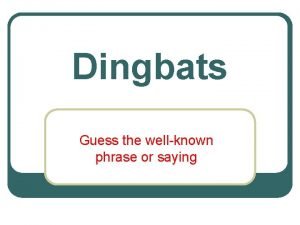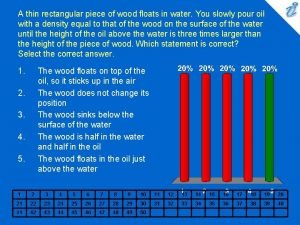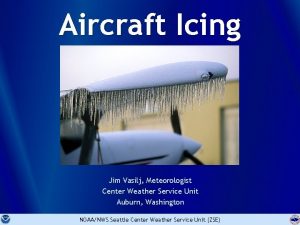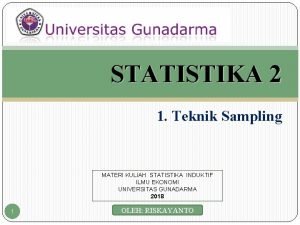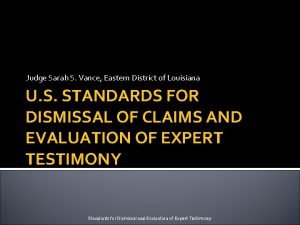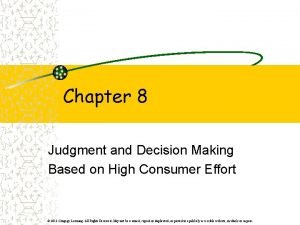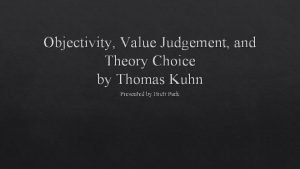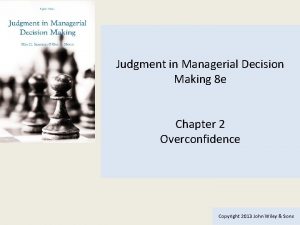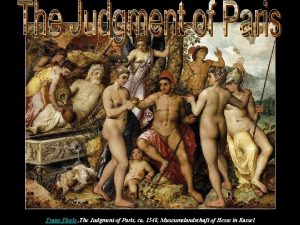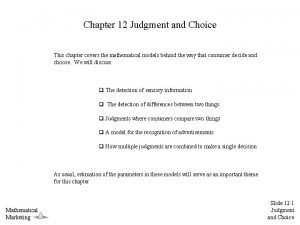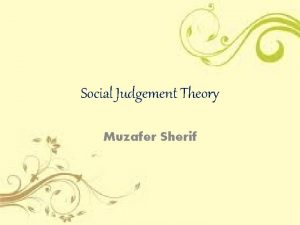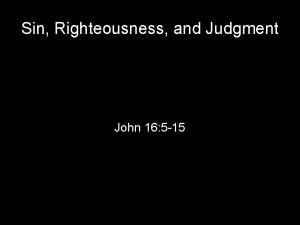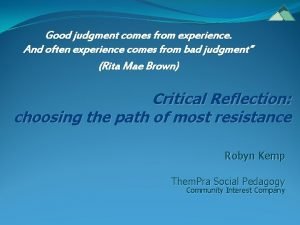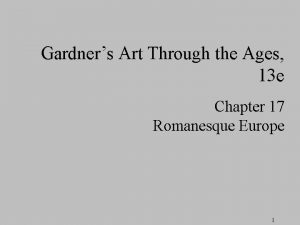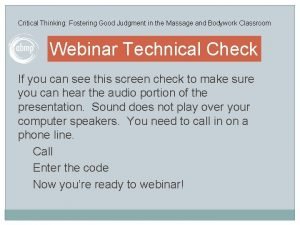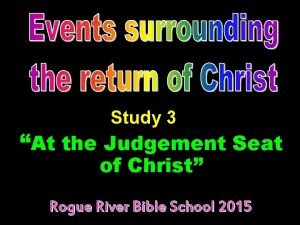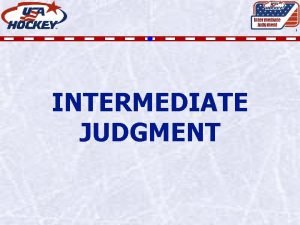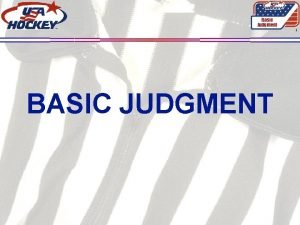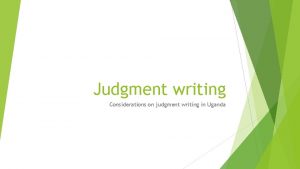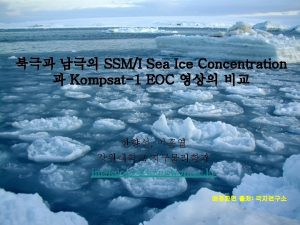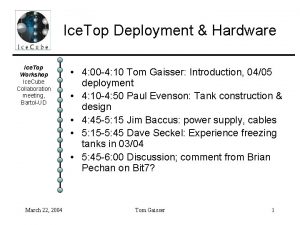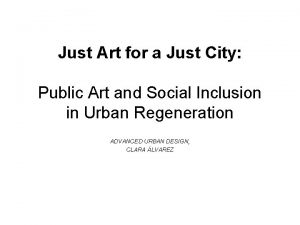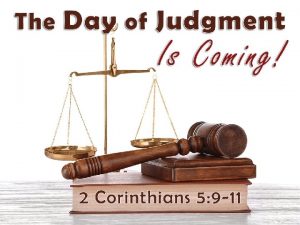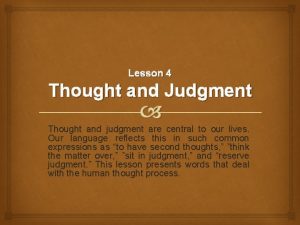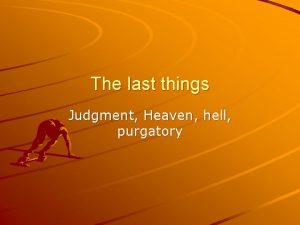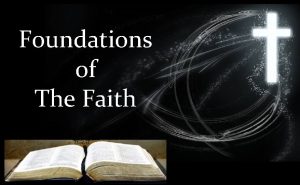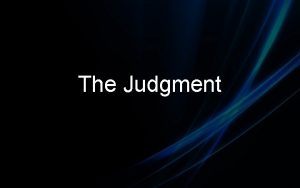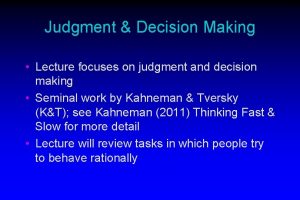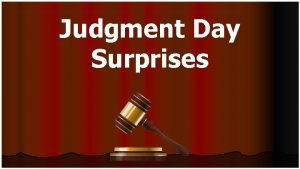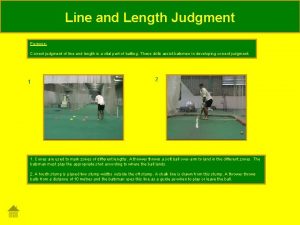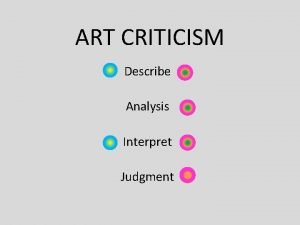THE ART OF JUDGMENT WRITING SIMPLIFIED JUST ICE























- Slides: 23

THE ART OF JUDGMENT WRITING: SIMPLIFIED JUST ICE N AS IR ASLAM ZAHID LECTU RE S ER IES SINDH JU DIC IAL ACADEMY 3 R D A ND 4 T H DECEMB ER 2015

WHAT IS THE ROLE OF A JUDGE? 1. Hear the parties 2. Record evidence 3. Determine the facts and legal issues 4. Critically analyse 5. Manage people in the courtroom 6. Maintain decorum and manage court room 7. Render a decision 8. Write a judgment

PLENARY DISCUSSION • A judgment is the result of application of law to the facts of a case. It is an expression of the final opinion of the Judge which he renders after due consideration of evidence and arguments advanced before him/ her. It is intended to put a final end to the controversies and disputes before him/her involved in the matter. • "Judgment would mean judicious determination of dispute between parties specifying grounds and substantial reasoning for arriving the particular decision. Judgment, held ought to be self contained, un ambiguous, conveniently intelligible, lucid and capable of only one interpretation without leading for guess or probabilities with regard to matters sought to be determined. Proper or valid judgment would be devoid of apparent vagueness, ambiguity or possibility of different or double interpretation. Bar of limitation for filing appeal , against decrees passed in utter disregard of legal requirement viz recording of reasons for granting decree would not be applicable"; Mistry Muhammad Hassan vs Haji Said Muhammad 1986 CLC 1241 (Quetta). • As lawyers in the recent past you have spent most of your time reading judgments written by others. You must now write them yourself. What you have read may have been good some even poorly worded and unclear. • DISCUSSION: From your experience what are the hallmarks of a good judgment?

NEVER ENDING PRECEDENTS CITED INCONCLUSIVE EVIDENCE IRRELEVANT EVIDENCE JUDGMENT TIME PRESSURE BAD COUNSEL ALLEGATIONS LIES

Brevity Clarity Precision

EFFECTIVE JUDGMENT WRITING 1. Avoid repeating yourself ( facts, names of counsel ) 2. Avoid pretentious jargon and legalese. It makes very little sense to the common man ( you don’t need to impress as much as you need for the litigants to understand what has happened. People are more likely to respect a judgment if they understand it). Avoid mangled pieces of murdered Latin! 3. Short and crisp sentences usually do. ( Multiple parties, charges, issues require longer judgments and longer sentences). Ensure that the judgment is not hard to read. What is hard to read is often hard to understand. Lahore High Court Judge who wrote 10 -40 page judgments in 3 -4 sentences! 4. Use one word instead of more than one when the meaning is the same. Example : At this point in time = now, During the month of December = in December. See handout.

5. Judgment must be issue-centric. 6. Sequence the Issues. Clarity of thought must be communicated in the writing and this is possible through organized writing. What is the sequence? ‘ 7. Avoid Overchronicaling. Not all dates are important. 8. Always remember to edit and proof read the document. ( Check for bad grammar, typos etc. ) 9. Avoid unnecessary preambles. Example It is important to add…. It is interesting to note… It may be recalled that….

WHAT IS YOUR STYLE OF JUDGMENT WRITING? What style do you prefer? Ask yourself? 1. Start with narrating the entire trial chronologically , one witness after another? A …. B…. . C…. . D…. . Z OR 2. Think and write in terms of issues and group relevant witnesses and issues under the issues as you decide on them.

JUDGMENTS FOR GRASSHOPPERS Former Justice Ian Binnie of the Supreme Court of Canada said judgments were written for grasshoppers ; hop to top- hop to the bottom, hop to the middle then hop to the top again.

WHAT SHOULD A JUDGMENT INCLUDE AND EXCLUDE? Facts Repeated information Matters which influence decisions Arguments of losing side Dead words Latin maxims

SUGGESTED STRUCTURE 1. Name of Court, Case Number, Name of Presiding Officer 2. Brief Opening: Facts without repitition and unnecessary detail. Relevant facts leading up to litigation. THINK OF IT AS A STORY OF WHO ALLEGEDLY DID WHAT TO WHOM /THEN THINK OF WHO IS ARGUING /CONTENDING WHAT. ( Also called helicopter view) 3. Frame the Issues – formulate the points for determination. 4. Decisions on the Issues 5. Decretal/ Operative Part- ensure this is expressed in clearest of terms without any scope for ambiguity. For example if it is a money decree , determine how much is to be paid to whom by whom. 6. Signature and Date

There is no reason why we cannot narrate facts in a simple but interesting way. See the lucid manner in which Justice Chandrachud (as his lordship then was) described the otherwise dull facts relating to ishing operations common in Cochin back waters in Lonan. Kutty Vs Thommen and Others 4 3 Sheridan’s The Rivals (1775) 4 1976 AIR 1645/1976 SCR 74/1976 SCC (3) 528 2 This 22 -year old litigation concerns the right of two adjacent owners to catch prawns on their respective lands. Survey No. 673 of Kadamkudi, District Ernakulam, measuring about 11 acres originally belonged to the Cochin Government but by diverse transfers the title thereto is now vested in the appellant, Lonankutty. The land is bounded on the West and South by a river. A portion of the land on the North-East can be put to agricultural use for a part of the year but the land, by and large, is water-logged and can profitably be used for prawn-fishing. In order to make fishing feasible, the appellant has constructed a bund on the western side of the land for arresting the flow of the river water. The contrivance is calculated to permit collection of water on the land, almost to the point of submerging it. The prawns enter the land with the high tide, they breed and multiply on the land, and the water while receding leaves the prawns behind. The appellant then catches them, presumably under a licence from the Government of Kerala. Survey Nos. 672, 677, 655/4, and 670, which sprawl on all sides of survey No. 673 belong to the respondents: Thomman and his mother Annam. We are concerned with the prescriptive rights claimed by them in respect of survey No. 672, which is situated towards the northeast of survey No. 673. Survey No. 672 is almost landlocked and between it and the river on the south stands the vast expanse of survey No. 673 belonging to the appellant. Prawns have an export value and catching them is so much more profitable than growing food-crops. But the respondent’s land being land-locked, they have no direct access to the river on the west or the south. They cannot therefore do any fishing operations because, for prawn-fishing it is necessary that the river-water must enter their land, and collect on it so that after the prawns have bred, the water can be released back to the river. For achieving this

result, respondents constructed a bund with sluice-gates on the border between their land survey No. 673. Their case is that they have a prescriptive easement to take water from the appellant’s land to divert it back through the same land, both for fishing and agriculture. The appellant has grave objection to permitting the respondents to engage thus in prawn fishing because along with the water which would pass from his land (survey No. 673) to the respondents' land (survey No. 672), prawns also would pass. And when the water would be released back from survey No. 672 through the sluice gates, survey no. 673 would get flooded, carrying back the prawns left on his land, to the river on the south. This is the genesis of the dispute between the parties.

FOLLOW THIS WITH ISSUES LIST WHICH WILL BE MAJOR HEADINGS FOR JUDGMENT Introduction List of issues First issue Second issue Third issue conclusion

Sort through this mess in 5 steps ( Raymond Method) 1. IDENTIFY THE ISSUES AND WRITE A CASE SPECIFIC HEADING FOR EACH 2. ARRANGE THE ISSUES IN A SEQUENCE THAT MAKES SENSE 3. WRITE A BEGINNING, TELLING THE STORY GIVING RISE TO ISSUES 4. ANALYSE EACH ISSUE 5. WRITE A CONCLUSION

Closer look at dealing with ‘ISSUES’ At the civil trial level, there are elements of the claim that parties contest. There are big issues which depend on constituent smaller issues. Example of a landlord disputing that the tenant has stopped paying rent This is the big issue. What are the constituent issues? Was there a contract? Did landlord for some reason forfeit his entitlement for rent? Did tenant infact make payments? Were alternate means of payment provided for in contract?

When you deal with issues sequence them logically. Simply don’t announce them. So if issues are whether the car ordered was delivered on time , whether it was in good quality/condition at time of delivery, whether it was the car specified by purchaser How would you sequence them? What comes first?

For contract matters: What were terms of contract What damages are due to claimant Was contract valid Was it breached? Remedy Is this logical sequence?

Civil Procedure Code Section 2(9) of the C. P. C: “judgment” means the statement given by the judge of the grounds of a decree or order Section 2(14) of the C. P. C: “order” means the formal expression of any decision of a Civil Court which is not a decree Section 33 of the C. P. C: Judgment and decree. -- The Court, after the case has been heard, shall pronounce judgment and on such judgment a decree shall follow.

Section 137 of the C. P. C: Language of subordinate Courts. -- (1) The language which, on the commencement of this Code, is the language of any Court subordinate to a High Court shall continue to be the language of such subordinate Court until the [Provincial Government] otherwise directs. (2) The [Provincial Government] may declare what shall be the language of any such Court and in what character applications to and proceedings in such Courts shall be written. (3) Where this Code requires or allows anything other than the recording or evidence to be done in writing in any such Court, such writing may be in English ; but if any party or his pleader is unacquainted with English a translation into the language of the Court shall, at his request, be supplied to him ; and the Court shall make such order as it thinks fit in respect of the payment of the costs of such translation. Section 152 of the C. P. C: Amendment of judgments, decrees or orders. -- Clerical or arithmetical mistakes in judgments, decrees or orders or errors arising therein from any accidental slip or omission may at any time be corrected by the Court either of its own motion or on the application of any of the parties.

Rule 1, Order 20 of the C. P. C: Judgment when pronounced. -- (1) On completion of evidence, the Court shall fix a date, not exceeding fifteen days, for hearing of arguments of parties. (2) The Court shall, after the case has been heard, pronounce judgment in open court, either at once or on some future day not exceeding thirty days, which due notice shall be given to the parties or their advocates. Rule 2, Order 20 of the C. P. C: Power to pronounce judgment written by Judge’s predecessor. -- A Judge may pronounce a judgment written but not pronounced by his predecessor. Rule 3, Order 20 of the C. P. C: Judgment to be signed. -- The judgment shall be dated and signed by the Judge in open Court at the time of pronouncing it and, when once signed, shall not afterwards be altered or added to, save as provided by section 152 or on review. Rule 4, Order 20 of the C. P. C: Judgments of Small Cause Courts. -- (1) Judgements of a Court of Small Causes need not contain more than the points for determination and the decision thereon. Judgements of other Courts. -- (2) Judgements of other Courts shall contain a concise statement of the case, the points for determination, the decision thereon, and the reasons for such decision.

CASE LAW On the public nature of court decisions: "The requirements that orders of court ought to be publicly made and announced is not only a matter of accepted judicial procedure , but invariably a requirement of law regulating the functioning of Civil and Criminal Courts". Lachmandas vs Central Govt cited as PLDI 973 SC 379 On the signing of the judgment : "The signing of judgment as envisaged u/s 369 of Cr. P. C is signing in open court at the time of pronouncement of the judgment and not signing at the home . in the case, therefore, the simple writing and signing of the judgment was wholly ineffective and did not operate as a bar to further proceedings"; Amin Sharif vs Syeeda Khatoon PLD 1962 SC 97.

On reasoning : "Trial court while recording its findings on merit of the case did not further discuss the evidence. It is not a reasoned judgment under Order XX"; Amir Tufail vs Muhammad Sadiq etc 2006 CLD 91; Mst Yasmin Akhter vs Abdul Mateen Zahid 2007 CLC 972. (Shariat Court AJ & K). On analysis of evidence: "Mere reproduction of evidence by the Appellate Court did not mean that the evidence of the parties has been discussed or referred to, judgment revealed cursory and casual approach of Appellate Court to the case. Judgment suffered from non-reading of evidence on record. Trial court had acted illegally etc. Judgment of the appellant was set aside and case was remanded to the Appellate Court"; Sayed Zulfiqar Hussain Naqvi vs Sayed Gulzar Hussain Shah 2005 YLR 2817. On the importance of issue-centric judgment writing: "Trial Court failed to give issue wise findings- Appellate Court while maintaining the judgment did not form points for determination ignoring mandatory requirements of O. XLI R. 31 C. P. C judgments & decrees of both the lower courts set aside" MST Feroza vs Anjumman-e- Ittehad-e- Baluchan & others 2004 YLR 1535 Kar.
 Art as disinterested judgment
Art as disinterested judgment Which two characters are detained by the watchmen
Which two characters are detained by the watchmen Just144ice riddle
Just144ice riddle Wood floats on water
Wood floats on water Icing
Icing Clear ice vs rime ice
Clear ice vs rime ice Judgement sampling adalah
Judgement sampling adalah Ncsbn next generation nclex
Ncsbn next generation nclex Summary judgment definition
Summary judgment definition Judgment chapter 8
Judgment chapter 8 Helen daughter of zeus
Helen daughter of zeus Objectivity value judgment and theory choice
Objectivity value judgment and theory choice Judgement in managerial decision making
Judgement in managerial decision making The judgement of paris
The judgement of paris Clinical judgment definition
Clinical judgment definition Judgment chapter 12
Judgment chapter 12 Contoh teori social judgement
Contoh teori social judgement John 16 5-15
John 16 5-15 Good judgment comes from
Good judgment comes from Romanesque portal diagram
Romanesque portal diagram Judgment massage
Judgment massage Jacob de backer last judgment
Jacob de backer last judgment What is righteous judgement
What is righteous judgement Judgment seat of christ
Judgment seat of christ


